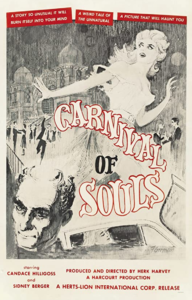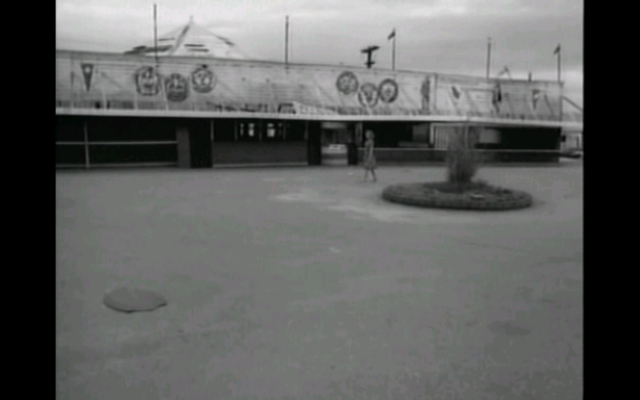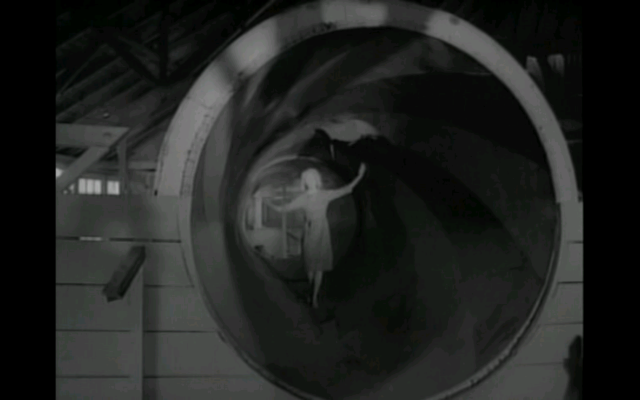|

Synopsis:
After emerging from a fatal car crash, a young woman (Candace Hilligoss) travels to her new job as a church organist in Utah, but remains haunted by the presence of a ghoulish man (Herk Harvey), and unable to emotionally connect with anyone around her.
|
|
Genres, Themes, Actors, and Directors:
- Horror
- Living Nightmare
- Untimely Death
Response to Peary’s Review:
Peary refers to this low-budget cult classic as a “sleeper that moviegoers always mention as one of their personal discoveries”. He comments on its “many clever ‘eerie’ scenes”, such as the two times when “Mary [Hilligoss] finds that she can’t hear anything and that people neither hear nor see her” (reminiscent of a “Twilight Zone” episode); the scene when she “climbs onto a bus, only to find that it is full of ghouls”; and the creepy finale at a deserted carnival pavilion. Indeed, for such a low-budget venture by a relatively novice director (this was Herk Harvey’s first and only feature-length narrative movie after a career in industrial film production), it possesses a surprising amount of atmosphere and panache, with striking b&w cinematography, creative direction, and a particularly noteworthy organ score by Gene Moore.
In his review, Peary argues that “rather than being a straight horror film, [Carnival of Souls] delivers a message similar to the one in Invasion of the Body Snatchers about how we are turning into pod people”, given that “Mary is such a passive, uninvolved (soulless) character”. (Interestingly, the Strasberg-trained Hilligoss apparently complained about this very description, and attempted to inject even more life into her protagonist.) Unfortunately, Peary’s review glibly gives away spoilers, as do other online reviews — so be duly forewarned; but chances are you’ll find yourself guessing the truth about Mary’s “situation” long before the end. Remade in 1998 by Wes Craven.
Note: According to TCM, Carnival of Souls was restored and revived in theaters in 1989, and made available on home video the following year, thus entering into mainstream moviegoers’ cultural consciousness just a few years after Peary’s GFTFF was published.
Redeeming Qualities and Moments:
- Candace Hilligoss as Mary

- Many genuinely frightening images

- Striking cinematography by Maurice Prather

- Effective use of pre-existing locales

- Creative direction and editing

- Gene Moore’s organ score
Must See?
Yes, as a genuine cult classic.
Categories
Links:
|






One thought on “Carnival of Souls (1962)”
A must, very suitable for revisits (I’ve seen it quite a few times). Enduring, one-of-a-kind flick that I get something out of each time I see it. However…
~does a cult film ever somehow fall out of favor? Even though ‘COS’ is now, thankfully, available in a Criterion Edition, I don’t seem to hear it talked about much. There could be a reason for that – which has less to do with the actual film. In its own way, ‘COS’ was very influential, for example, on ‘Night of the Living Dead’. But Romero’s film spawned not only his own sequels but copycat films galore – thus keeping the original ‘Night…’ ever-present in the minds of ffs.
‘COS’, on the other hand, is pretty much just ‘COS’. There really isn’t another film like it. So you do, kind of, have to be aware of its existence and go looking for it.
I don’t really see the connection between ‘COS’ and ‘Invasion of the Body Snatchers’. I suppose one could draw one out but the main difference there is that ‘Invasion…’ appears to be referring to mankind in general. ‘COS’ has its focus on a very specific individual – one who, unlike the Pod People, is not an unthinking conformist but a consciously anti-spiritual non-conformist.
One of the most intriguing aspects of ‘COS’ is the various sections of it that can possibly be open to interpretation. (In that regard, one wonders about the extra reel of film supposedly lost by the film’s developer – though, even so, the film does still feel very complete.) The lack of satisfying answers allows the audience to do its own homework to an extent (an element I personally prefer).
For a low-budget, one-off flick, this is a rather impressive effort. It’s filmed with forcefulness and acted surprisingly well (considering that most of the actors are not particularly professional).
Whenever I go back to this film, I’m reminded of how just how original it is. I’m always recommending it to people.
Note: I believe the beginning of ‘COS’ also influenced the first episode of David Lynch’s tv series, ‘Twin Peaks’ (i.e., the girl on the bridge). I also think, for several reasons (i.e., certain scenes, settings & the mood to an extent), that ‘COS’ would play very well back to back, oddly, with Woody Allen’s ‘Stardust Memories’. But that could just be me. 😉